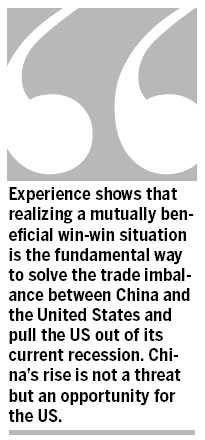
US should stop blaming other countries for its economic problems and be more open-minded and embrace globalization
During his recent visit to China and Japan, US Treasury Secretary Timothy Geithner discussed sanctions against Iran and the global economy. His visit came at a time when the US economy still shows no sign of recovery, the European debt crisis still needs a solution, and growth in emerging economies is slowing down. Although the job market in the United States did show some signs of improvement in the second half of 2011, the jobless figure is still high, and the real estate market in the US is still sluggish. Meanwhile, Obama's goal to double US export growth by 2015 seems a long way out of reach.
Although the US has stopped short of calling China a currency manipulator, the US has blamed China's exchange rate for the trade imbalance between the two countries, which reached $202.3 billion in 2011. During his visit, Geithner argued that China should continue to let its currency appreciate. But it is inappropriate for the US government to pressure for greater renminbi appreciation as China's trade surplus has been steadily falling since the global financial crisis, to $155.14 billion in 2011, a decline to about 2 percent of GDP from the previous year's 3.1 percent. And a recent report issued by China's central bank shows the renminbi has risen 30.2 percent against the dollar since July 2005, when China started to reform its currency mechanism.
In fact, the trade imbalance between China and the US is the result of the following four factors:
First, asset bubbles in the US that spurred export volumes from China.
Second, since China joined the World Trade Organization (WTO) in 2001, global capital has been flowing into China, bringing about a rapid increase in its processing trade surplus. Meanwhile, low salaries, together with relatively low domestic commodity prices, have strengthened the price competitiveness of Chinese goods in the global market.
Third, the processing trade, which accounts for over 50 percent of China's total trade, inevitably results in a trade surplus since China exports products made of processed imported goods. Chinese companies keep only the processing fees, while the majority of the profits go to transnational corporations.
Fourth, China maintains an advantage in labor-intensive products, but the growth in wages has not kept pace with the growth in productivity. China needs structural changes that result in fairer income distribution, greater domestic demand, improved social welfare and better protection for the environment.
Fundamentally though, the US' trade deficit is caused by its over-consumption and low savings rate. The US is a big spender on the military and government. Therefore, the US needs to cut its government and military spending to reduce its trade deficit.
The US inevitably seeks to find external reasons for its domestic problems rather than confronting the need to put its own house in order. Despite having a trade deficit with China, the US still restricts its exports of high-tech products to China and sets up barriers for Chinese companies investing in the US. The US should be more open-minded and participate more in economic globalization.
The US is also used to imposing its own views on others and believes it has the right to put other countries on a "black list". For instance, the Treasury Department of United States has the right to declare China a currency manipulator, which is against WTO rules and international law. The US is also putting pressure on China by seeking its support on financial sanctions against Iran. However, China consistently opposes any country overriding international law.
Experience shows that realizing a mutually beneficial win-win situation is the fundamental way to solve the trade imbalance between China and US and pull the US out of its current recession. China's rise is not a threat but an opportunity for the US. If the US can lift its export ban on high-tech products to meet the huge demand created by China's urbanization and modernization, it can further share the fruits of China's economic growth.
The US should also reduce trade protectionism and reduce its barriers against Chinese companies investing in the US. Lastly, the US should enlarge the number of Chinese people who travel, study and emigrate to the US, therefore boosting its job and real estate markets.
The author is a professor at the China Center for International Economic Exchanges.
(China Daily 01/16/2012 page8)